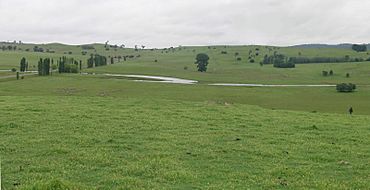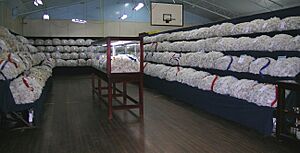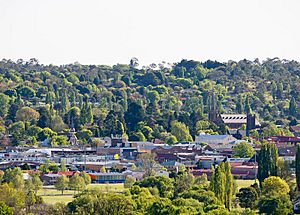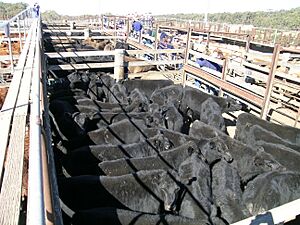Northern Tablelands facts for kids
Quick facts for kids Northern TablelandsNew South Wales |
|||||||||||||||
|---|---|---|---|---|---|---|---|---|---|---|---|---|---|---|---|

|
|||||||||||||||
| LGA(s) |
|
||||||||||||||
| State electorate(s) |
|
||||||||||||||
| Federal Division(s) | New England | ||||||||||||||
|
|||||||||||||||

The Northern Tablelands, also called the New England Tableland, is a high, flat area (a plateau) in northern New South Wales, Australia. It's part of the Great Dividing Range, a long chain of mountains. This region stretches from the Moonbi Range in the south all the way to the Queensland border in the north. It's a beautiful area known for its high lands and cool weather.
Contents
Geography and Climate of the Tablelands
These tablelands are the biggest highland area in Australia, covering about 18,197 square kilometres. Many spots here are over 1,000 metres high. The highest point is Round Mountain, which is 1,584 metres above sea level. Imagine standing on top of Australia's highest railway station, which used to be at Ben Lomond!
Soils and Plants
The Great Dividing Range has created many different types of soil in the Northern Tablelands. Most soils come from basalt, granite, or river sediments. The main type of plant life you'll see is the New England Peppermint Grassy Woodland.
Amazing Gorges and Waterfalls
The eastern side of the Tableland has amazing gorges, thick rainforests, and beautiful waterfalls. More than 25 National Parks protect these areas. Three of these parks are so special that UNESCO has listed them as World Heritage Areas. They are part of the Central Eastern Rainforest Reserves. You can visit places like Werrikimbe National Park and Oxley Wild Rivers National Park. The New England National Park is also a World Heritage site.
Rivers and Water
Many rivers start in the eastern part of the Tableland and flow towards the coast. These include the Clarence, Macleay, and Manning rivers. Other rivers flow inland and join the Gwydir, Namoi, and Macintyre river systems. These are all part of the huge Murray-Darling River Basin. The biggest dam in the Northern Tablelands is Copeton Dam on the Gwydir River.
Weather in the Highlands
Because the tablelands are so high, summers are cool and rarely get hotter than 32 °C. Winters are cold, with snow sometimes falling and many frosty mornings. Temperatures can drop to -10 °C in places like Armidale, Guyra, and Walcha. But usually, these cold mornings lead to clear, sunny days. The Northern Tablelands gets a lot of rain, from 650 mm in the west to over 1,200 mm in the east. Most of this rain falls during the summer.
History of the Northern Tablelands
Australian Aboriginal people have lived on these tablelands for thousands of years. Before European settlers arrived, several language groups, like the Anaiwan people, lived here.
Early European Settlement
In 1818, John Oxley explored the Walcha area. Later, in 1832, Hamilton Collins Semphill started a farm called Wolka (Walcha) in the Apsley River valley. Other settlers followed, looking for new land. By 1844, there were many sheep and cattle grazing here. Armidale became a town in 1849 and is now the main city and administrative centre of the region.
Challenges and Gold Rush
The arrival of settlers led to challenges for the Aboriginal people. There were many conflicts in the southern part of the Tablelands between the 1830s and 1860s.
In 1852, gold was found at Rocky River. Soon, thousands of miners came to the area. Gold was also found at Bakers Creek, Hillgrove, in 1857. This led to a boom in mining, but it became harder and more expensive to dig for gold after 1900.
Captain Thunderbolt
Captain Thunderbolt (Frederick Wordsworth Ward) was a famous bushranger who escaped from prison. He came to the Northern Tablelands and robbed farms, mail coaches, and hotels. The government offered a reward for his capture. Many stories are told about his adventures. In 1870, he was shot and killed by a police officer near Kentucky Creek. His grave is in Uralla.
Towns and Education
The Northern Tablelands includes towns like Armidale, Glen Innes, Guyra, Tenterfield, and Walcha.
The University of New England in Armidale was started in 1938. It was the first Australian university built outside a capital city. Today, it's a major university, especially for students who study from home.
Economy of the Northern Tablelands

The Northern Tablelands covers a large area, with many farms producing goods worth over $320 million each year. Most of this money comes from raising animals, especially beef cattle, sheep, and wool.
Farming and Livestock
There are about 792,000 beef cattle and 3.1 million sheep in the region. Areas around Armidale, Uralla, and Walcha are famous for their very fine wool. Walcha also has a big, modern dairy farm. Guyra is known for producing prime lambs, potatoes, and tomatoes grown in glasshouses. Fruits like apples, pears, and other stone fruits are grown in places like Kentucky. Farmers also raise pigs and bees, and some vineyards have started growing grapes for wine.
Other Industries
Gold and antimony (a type of metal) are mined in Hillgrove. A company called Lockheed Martin operates a satellite tracking dish near Uralla. This shows that the region has a mix of traditional farming and modern technology.
Flora and Fauna of the Northern Tablelands
The Northern Tablelands is home to a huge variety of plants and animals. You can find thousands of different species here.
Common Trees
Many types of eucalyptus trees grow across the Northern Tablelands. These include Black Sallee, Blakely's Red Gum, and New England Peppermint. You can also see wattles (Acacias), native apples, and river oaks.
Rare Plants
Some plants are very rare. For example, the Bolivia Hill boronia and the shrub Pimelea venosa are only found in a few specific spots. You might also spot some rare Hillgrove gum trees in Oxley Wild Rivers National Park. These trees have unique, mottled green trunks with peeling yellow-brown bark.
Wildlife and Conservation
Unfortunately, some animals in the Northern Tablelands are endangered. The endangered Hastings River mouse lives in the forests around Werrikimbe National Park. The brush-tailed rock-wallaby can be found in isolated parts of the Oxley Wild Rivers National Park. The Bundarra-Barraba Important Bird Area is one of only three places in New South Wales where the endangered regent honeyeater breeds. Protecting these special animals and their homes is very important.
See also
 In Spanish: Mesetas del Norte para niños
In Spanish: Mesetas del Norte para niños



